The Vestal Fire
At the heart of the Forum Romanum lay the sacred fire of Vesta. Kept alight by the Vestal virgins who maintained the temple, the flame represented the good will of the namesake goddess of hearth and home. Hidden from the eyes of the public, the flame was to never be extinguished, save for its annual renewal at the start of the year; belief was that its premature extinction would portend calamitous ruin for Rome. Today, we live in a world brimming with these “vestal” fires, as environmental historian Stephen Pyne calls it: modernity’s anthropogenic flames that survive through human artifice, always burning, a resource on tap, religiously coveted by those at the altar of capitalism. Whether it consumes oil, coal, or takes the euphemistic form of “energy,” the flames that power our society, much like the sacred fire of that temple, burn continuously and out of sight. As it was in Rome, the very possibility of their extinction frightens us still. The prophets of the gas pump assure us of apocalypse if anything were to happen: nothing short of total collapse.
But behind these warnings and our whispered self-assurances lies the repressed knowledge that our control is slipping, if we ever had it at all. The temple of Vesta was victim to one of the most famous fires in antiquity — the burning of Rome under the reign of Nero, a reminder that these temples can so easily fall to the flames they are erected to worship. We face a similar reminder today as our world reckons with the beginnings of the unprecedented climatic shifts to come. Yet while the fires that burned Rome were wild and tangible, those that consume us today are invisible, unceasing; they are our vestal flames, hidden away in our furnaces and factories, as savage as the feral conflagrations that scorch the Earth each summer, but far more pernicious in their unseen diligence. As media theorist John Durham Peters writes in his analysis, the world has never witnessed so much flame, yet “modernity’s rule is to keep fire increasingly out of sight… and the more fire goes out of sight, the harder it is to manage.”
We begin here, with the vestal fire, because it introduces us to the central paradox at the heart of our media’s reckoning with climate change — our visible flames are not the most pressing ones. Rather, it is the obscured, the invisible that truly matters. In climate change, Vesta — the one goddess almost never depicted in classical art, an “interior not to be revealed” — meets her mirror, an exterior that defies revealing. This new deity, summoned by our industrial temples, forces us to confront the deceptively simple question: How can we make real that which is unseen?
Seeing is Believing
The question of how we might make climate change visible is one that has long plagued environmentalists and scientists alike. What’s at stake is nothing short of climate change’s very reality. To state the obvious, climate change’s material reality remains assured independent of its representation, steadily steamrolling towards catastrophe; nonetheless, its status as an object in our environmental ontologies, as a cogwheel integrated into the larger machinery of our worldview, is importantly tied to the success of its media. As the environmentalist Leo Aldopold noted, “we can be ethical only toward what we can see, understand, feel” and so making climate change visible has been a critical task for those seeking to combat it.
This outsized importance of visibility can be partially traced back to the ocularcentric culture that arose in modernity. Spurred by rapid advancements in our specular technologies, an increasingly empiricist epistemology, and the spread of mass media networks premised on visuality, sight became the primary modality by which our sense of the world was constructed. Photography opened up the depths of the “decisive moment,” film let us record “truth 24x per second,” and the world became unveiled to us as a succession of images, sights to be taken in. Visual media gained a life of their own within the domain of the real, no longer simply a “reflection of… reality,” as Baudrillard notes, but an object with independent standing. To be rendered visually was to be made real. In short, “pics or it didn’t happen.”
This proved particularly true for climate change, as media representations proved necessary to bring it forth as a cohesive phenomenon. Unlike the traditional objects that populate our ontologies (rocks, trees, forests, forest fires), climate change is exceedingly vast and complex — a “hyperobject,” in philosopher Tim Morton’s words, a phenomena of such expansive temporal and spatial dimensions that it defies not only our sensory capacities, but our very ideas of what an object is. As such, media — those things that serve as intermediaries between us and it — are essential in distilling this mega-phenomenon into a form where we might be able to encounter it. As Birgit Schneider and Thomas Nocke note in their introduction to Image Politics of Climate Change, even the discovery of climate change was premised on our ability to visually mediate it. “It was only through these new strategies of visualizing numbers of observation and measurement,” they write, “that the climate became evident, and as such, an epistemic object of research.”
That which makes it necessary to mediate climate change is precisely that which resists our attempts at representing it.
But this status as a hyperobject is also what makes it so challenging for climate change to be properly captured by our image-making apparatuses. Though we may catch the occasional wildfire or flood arising from it, the thing itself constantly eludes our grasp — it is, to use Kantian language, more noumenal than phenomenal. When George Perkins Marsh wrote that “the power most important to cultivate, and, at the same time, hardest to acquire[,] is that of seeing” in Man and Nature, he might as well have been talking about this challenge. It is a cataclysm that is notoriously large, yet unspectacular. Rob Nixon centers this fact in his environmental critique, arguing that climate change enacts “slow violence,” a “violence that occurs gradually and out of sight, a violence of delayed destruction that is dispersed across time and space, an attritional violence that is typically not viewed as violence at all.” That which makes it necessary to mediate climate change is precisely that which resists our attempts at representing it.
Wresting climate change from this invisible chasm and thrusting it into the realm of perceptibility is therefore no simple task. When we turn to the contemporary mediascape, we see a variety of aesthetic strategies being employed to bring it to life in our scientific, emotional, and political lives. While each of the strategies have their distinct advantages, they also collide with unique representational issues stemming from the complexity of its subject and their own medium-specific limitations. Key to success, then, is building a robust visual ecosystem that is flexible and resilient enough to withstand each of these challenges. Tracing the history of these various strategies reveals an ongoing negotiation between our representations of climate change and the discursive role we need the concept to have. It also reveals a critical gap within this media ecology — one that betrays an inability to envision a future with possibility.
The Ghost & Its Body
Scientific visualizations played an essential role in initially revealing climatic phenomena to us as a tangible reality, in translating the ephemera of theoretical data into concrete parts of our materialist worldview. We need to look no further than the “ozone hole” — an aspect of climate change so widely known to us now that its existence seems self-evident — to observe how media have the ability to ground scientific phenomena and data, giving a body to this mathematical ghost, and making it “real” to us as a physical feature of our lived worlds.
Ozone abnormalities in the polar region were first discovered by British scientists involved in long-term, local research at the Antarctic. Measurements taken over the course of several years at two stations (Halley and the Argentine Islands) revealed a drop in total ozone values beginning in the 1980s, which led these researchers to identify a phenomenon they coined “ozone depletion.” Critically, however, the phenomenon at this stage was still conceptualized as a mathematical trend (i.e., a depletion), rather than an emergent feature of our tangible environment (i.e., a hole). It was only when British research was integrated into a more sophisticated apparatus involving satellite data and computer visualizations by NASA that this categorical transition would occur. As Sebastian Vincent Grevsmühl tells us, while NASA initially missed the phenomenon of ozone depletion because their “big science” approach resulted in a glut of white noise that obscured the relatively subtle fluctuations picked up by the British scientists, their more global approach was ultimately able to make out a “veritable hole in the sky” where their British counterparts only saw depletion.
Central to this pivot was not simply NASA’s access to bigger data sets, but its strategy of visualizing this data by analogy to cartography. In particular, this happened through its use of isolines, or contour lines — cartographical features initially used in a maritime context to identify terrestrial features — to integrate its 140,000 daily ozone measurements into a single image: the topography of the ozone. This shift was subtle, but profound, particularly for a species that is notoriously bad at seeing statistical trends and long-term data as threats. By using contour lines, scientists were able to “create shapes and delimitate a space, allowing them… to create holes,” where previous visual methods (like plotting values against a grid) had only been able to depict “tendencies such as decline or depletion,” as Grevsmühl writes. It gave ozone depletion distinct spatial characteristics and bounds, transforming it into an object that you could “see.” The change was not merely nominal, but ontological — the cartographic visualization transformed the phenomena of general depletion into a discrete object by positioning it as a feature of our landscape, allowing the public to digest this complex stream of data in spatial, materially grounded terms. In doing so, it communicated the immediacy and presence of a threat that had previously remained abstract. As the political scientist Karen Litfin writes, the ozone hole played a significant role in the Montreal Protocol negotiations, by providing “dramatic evidence in favor of precautionary action, evidence that participants could not ignore.” While a downtrending graph could’ve been easily shrugged off, “few people [could] ignore a hole the size of the continental USA,” ultimately leading to the limited-access model of the upper atmosphere we have today.
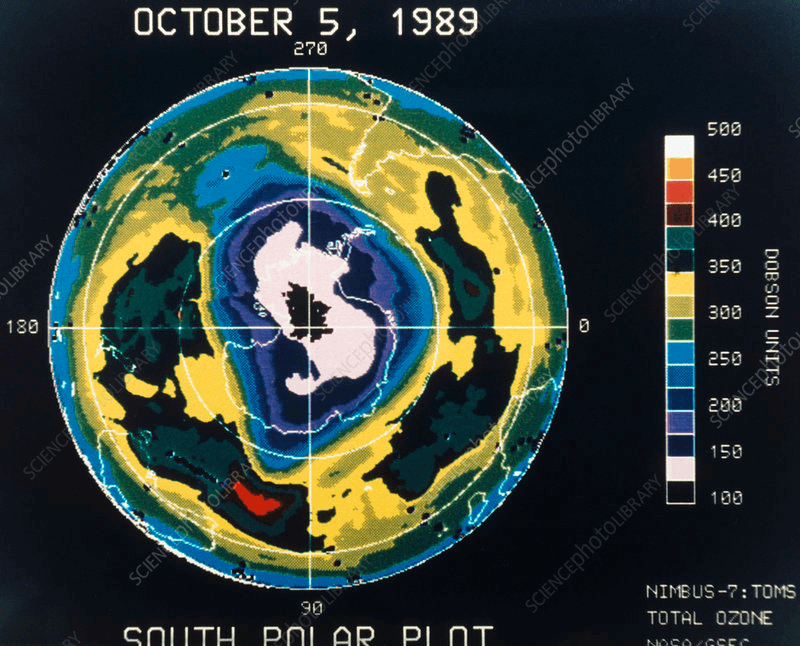
But these graphical, scientific visual modes, while being able to modify our popular ontologies to capture the threats of climate change, come with some built-in liability. They are not simply agnostic representations, but “materialized arguments,” as science historian Norton Wise calls them. Similarly, Grevsmühl reminds us that the visual strategy chosen to depict this data was not some a priori inevitability. Rather, these projection types, like all others, were ones “chosen from amongst a large panoply of cartographic products.” As such, “one should certainly not consider it ‘a transparent opening to the world’ but rather, as any form of art, ‘a particular human way of looking at the world.’” These visualizations necessitate a degree of artifice and elision; contour lines, after all, construct the illusion of continuity between discrete data points, and other scientific visualizations participate in similar graphical metaphors. This human intervention, however, leaves these visuals up for debate — as any “argument” does — and can easily be leveraged to undermine trust in their validity.
The most famous instance of such a subversion involves a visual that was critical in popularizing the notion of climate change — the “hockey stick” graph. First published in Nature, the graph depicts global temperatures over several centuries with a radical “hockey stick” shaped upturn beginning near the Industrial Revolution. Combining complex reconstructive analysis of past temperatures via tree-ring width, ice-core thickness, and the like, the graph integrates heaps of complex analysis into a familiar and digestible format, and its popularity was one of the first major breakthroughs in climate change comms. But there was a catch. One of the datasets included in this analysis corroborated the other trendlines for a majority of the graph, but diverged from them in the 60s, when it dipped rather than following the precipitous rise seen in the other lines.
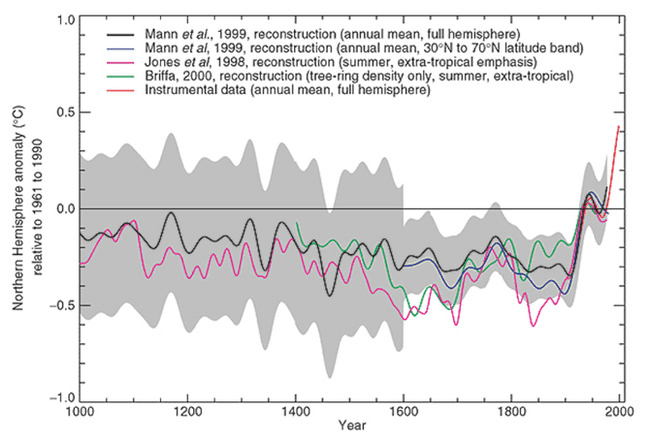
Ultimately, the researchers behind the study would choose to obscure the divergent line for the sake of clarity, following scientific best practices. But an email hack that revealed the conversations surrounding this decision would explode into the “Climategate” scandal that would plague climate scientists for years to come. Though these scientists weren’t found in breach of any ethical practices by their peers, the discovery that these graphs were not “inscribed by nature itself” but rather rhetorical constructs proved disastrous within the public sphere, casting doubt over the entire notion of climate change, as Lynda Olman, a researcher in STEM rhetoric, notes. Moreover, similar statistical methods would soon be adopted by skeptics, who would use cherry-picked data to create visually analogous media that would contradict the ones pointing towards climate change, as illustrated in Twist and Shout: Images and Graphs in Skeptical Climate Media.
These scientific visualizations, then, run into distinct limitations when it comes to their medium-specific constructedness. In violating the myth of natural inscription, and in their intrinsically rhetorical structure, they open themselves up to both critique and co-option. The ozone hole showed how critical these visualizations could be in making abstract phenomena real to us, altering our environmental ontology and transforming data into material reality. But Climategate and the hockey stick graph showed us the attendant risks of this mode. To satisfy this myth of natural inscription, we need to turn to a different medium: photography and film.
To Witness
The indexicality of film has long been a central motif throughout film theory. This term, stemming from Charles Peirce’s theory of signs, distinguishes icons, which resemble an object by analogy, from indices, which share a direct physical, causal link to their subject. Unlike scientific visualizations, which necessarily involve some degree of human intervention or interpretation, photographs operate via a mechanical process in which light directly acts on film to produce an image. It’s the automation of this process that gives it this particular weight of truth, the ability to serve as an independent witness. As film theorist André Bazin writes in his foundational text The Ontology of the Photographic Image, photography “completely [satisfies] our appetite for illusion by a mechanical reproduction in the making of which man plays no part,” its “objective nature… confers on it a quality of credibility absent from all other picture-making.” Whereas scientific visualizations played a critical role in introducing climate change into our material worlds by concretizing scientific data, photography and film communicate the urgency of climate change by serving as witness to its harshest impacts.
The most recognizable of these images seared into the cultural imaginary is that of the lone polar bear, adrift among the melting Arctic ice. As Dorothea Born notes in her piece Bearing Witness, while the first popular images of polar bears focused more on the “family-idyll” dimensions of their lives — leaning on cuddly anthropomorphic depictions to foster an emotional bond with the animal — later images would connect them more broadly to the Arctic ecosystem, ultimately resulting in images that foreground the “danger the bears are in” to symbolize ecological precarity at large. As a result, the bear took on a complex layering of meanings as these modes evolved. On the one hand, the bear’s anthropomorphized past instilled an emotive identification with the animal; their pain was recognizable and saturated with the gravity of the real, thanks to the indexicality of the photographic image. Head-on shots allowed the bears to meet our gaze, invoking a Butlerian “scene of address” wherein they called upon us to acknowledge them as subjects, beings with lives full of moral worth. At the same time, more distant shots of the bears within a broader environmental context imbued the animal with an increasingly symbolic role — turning them into a synecdoche for the ecosystem as a whole. Through the bear, we were to see the entirety of the Arctic, and through the Arctic, the natural world. As Born writes, “their misery and sorrow function as a stand-in for humanity’s problems and the drifting ice floe becomes a metaphor for earth’s vulnerability.”
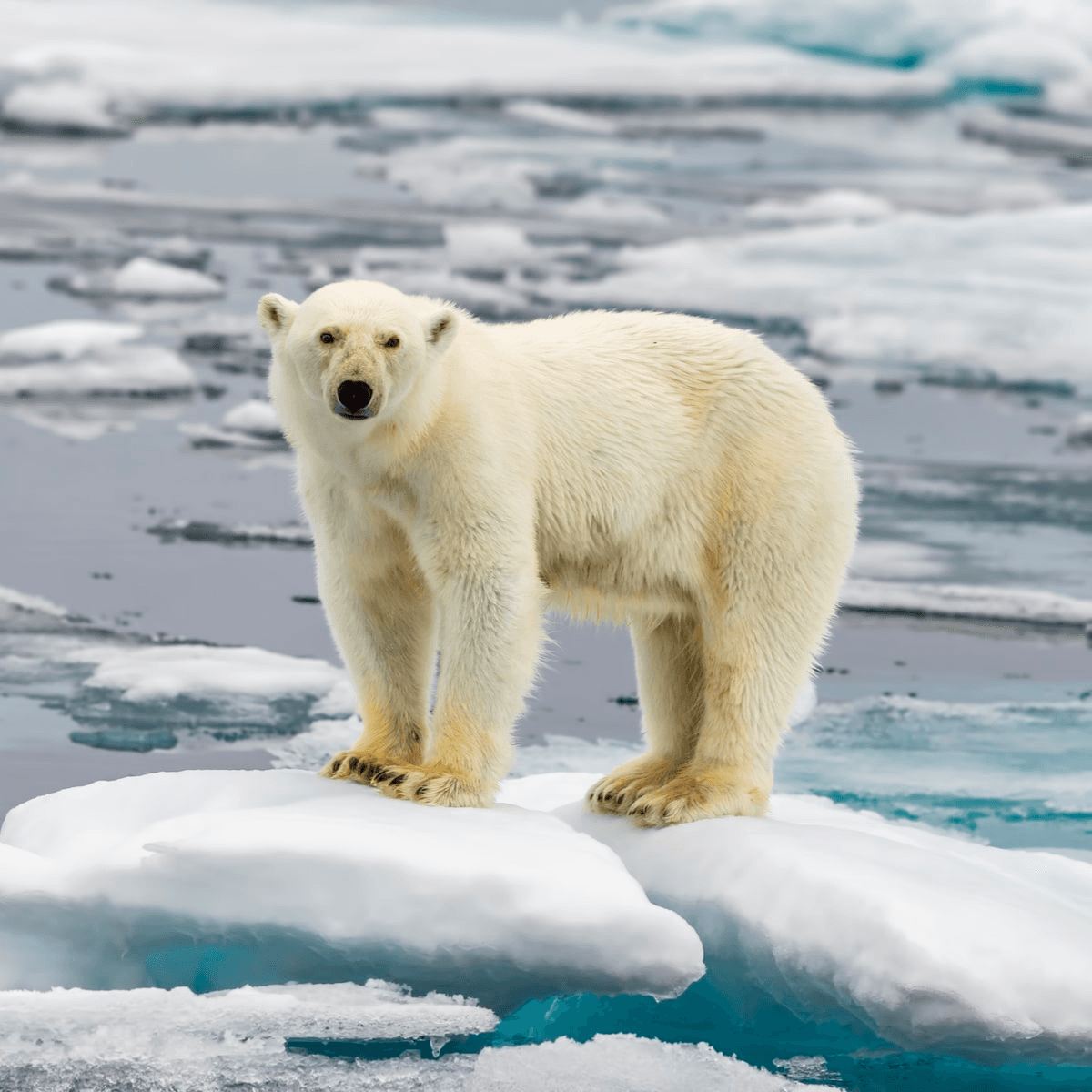
The polar bear was at once self and Other, a documentary image of literal suffering and a symbol for the broader suffering of the environment. This opening up from the particular to the general, the literal to the figurative, is the fulcrum on which this mode turns. Ultimately, photography aims to foster an emotional connection to the wider ecosystem through a commitment to the particular. The bear serves as an affective amplifier, and our identification with its suffering is meant to open us up to a broader identification with the plight of the natural world. In doing so, it faintly echos the ecofeminist tradition of articulating an “ethics of caring friendship, or ‘a loving eye,’ as a principle for relationships with nature,” as Margarita Estévez-Saá and María Jesús Lorenzo-Modia describe in Women’s Studies.
Of course, it’s no guarantee that an emphasis on the particular will be successful in opening us up to this broader form of care. The strategy of using “charismatic megafauna” — or “cute and cuddly” creatures that are also “wonderfully large, real, and alive,” as the environmental studies professor Cheryl Lousley describes them — to cultivate an ecologically-centered mindset has been criticized for inadvertently narrowing our sympathy to only those creatures deemed approachable enough to deserve our affection (sorry blobfish, bugs, and arachnids). The aniconic concern that we might misplace our devotion to the icon rather than the thing the icon represents remains at large here, and some have emphasized how this can easily transform nature into spectacle, giving rise to a fetishistic relationship grounded in consumption rather than care.
Even if this impulse is resisted, others have noted how this mode’s reliance on imagery that takes place far from our human worlds simplifies the complex realities of climate change, rendering any such care toothless. As the cultural scientist Vera Tollman writes, in most of the media that falls into this genre, “the polar bear on the ice remains a pure and beautiful image, never coming into contact with the world of humans.” William Croton speaks to the alienating potential of such images void of human life when he writes that we might easily begin to think that “the place where we are is the place where nature is not,” and “if this is so… then also by definition [human life] can offer no solution to the environmental and other problems that confront us.” This not only obscures the larger systemic causes of climate change, but also positions the effects of climate change as something that happens solely “out there,” far from our human domain of affairs.
In response to these limitations, alternative strategies have cropped up in an attempt to center human industrial activity in their depictions of climate change, ensuring that our place in the catastrophe is clearly carved out. A popular example of this is what one might call the “industrial sublime” mode. It’s a technique that can be found in films like Koyaanisqatsi or Anthropocene: The Human Epoch, and involves a god-like perspective (e.g., timelapses, aerial footage) turning its gaze towards human activity. By appropriating the grand aesthetic typically used by popular media to depict the natural world — think of the epic timelapses and drone shots that litter Planet Earth, which carry on the Romantic tradition of depicting nature as a sublime, transcendent force — and applying it to human activity, it visually frames our consumption as a force of nature. Timelapses of human activity chipping away at natural ecosystems like forests show our activity as it might the destruction of a wildfire. It is a visual strategy designed for the Anthropocene, an aesthetic that allows us to depict an ecology defined primarily by human impact. It is a form of nature documentary about humans.
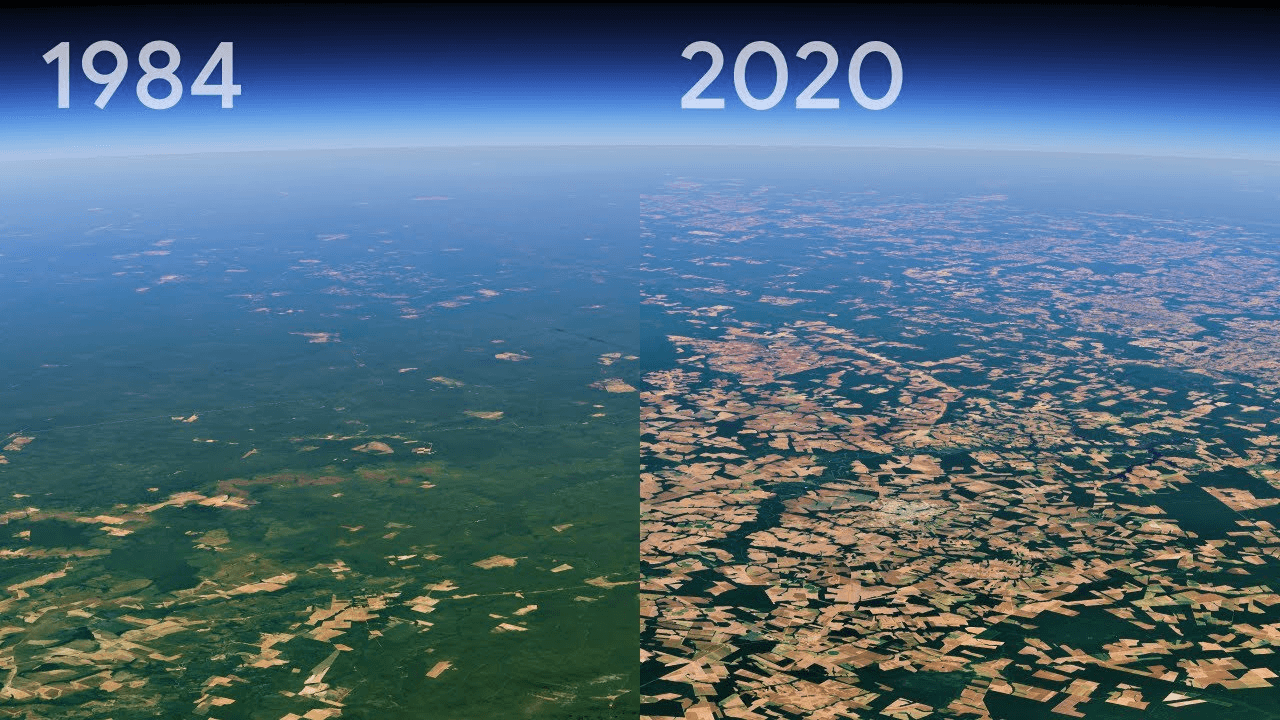
Like the polar bear images before it, cultivating affect remains a key strategy for this mode, but a few elements distinguish this strategy. While the polar bear genre attempts to elicit sympathy for its iconic mascots by depicting their suffering, this mode is far more concerned with cultivating a mood through an evocative combination of transcendent imagery and experimental sound. Unlike sympathy, which has an intentional object towards which it directed, moods — following in the Heideggerian tradition — are world-revealing. They aren’t about specific things per se, but rather express a particular relationship between a subject and world. In the case of the industrial sublime genre, it reveals the “natural” as the “human” (and vice versa), showing us that the Man/Nature dichotomy that we use to bifurcate the world is a false construct. Instead, it reveals that our human world is necessarily inseparable from nature.
In this way, the “industrial sublime” strategy tries to overcome the narrowness of the charismatic icon and its attendant limitations. The narrow, synecdochic mode is replaced with a focus on mood that takes as its subject nothing short of all of it — revealing the world as one in which we are embedded within nature, not observers at its periphery. Yet, this mode, in elevating humanity to the transcendent, also alienates us from our own agency. As we witness the sheer scale of our actions, we might come to understand our collective enmeshment in the natural world, but we also grow to feel that there’s nothing that can be done; the overwhelming sensation that these media cultivate is despair, helplessness in the face of what we have created. Researchers have corroborated this intuition, noting that although negative emotions — the primary drivers of both the polar bear genre and industrial sublime — are effective at generating attention, they also lead to disengagement. Instead, what we need is a visual tradition capable of motivating praxis, and therefore, change.
Techno-Optimism At The End of the World
When we look at the mediascape around us, a gap becomes clear. Though we have figured out how to turn data tangible through scientific visualizations, and to cultivate an affective relationship to the green world through photography and film, there are few visual traditions that have been able to imagine what a path forward might look like, to craft an aesthetic of possibility. As the oft-quoted refrain attributed to Fredrich Jameson goes, “it's easier to imagine the end of the world than the end of capitalism,” and our media largely betrays this sentiment. Our imagined visions of the future have never been less rosy, and as we witness film after film depicting our gruesome ends, we become inured to the urgency of the cataclysm we face.
The drought of possibility is more than just disheartening, not to mention potentially disengaging; when all we see are views of the future defined by antagonism, even our proposed solutions inevitably adhere to this logic. No wonder so many prominent geoengineering proposals can be summed up with the maxim, “if something is wrong with the sky, shoot at it,” as science historian James Rodger Fleming writes. Still, amidst the ashy wastes of our resigned mediascape, seedlings of new strategies are beginning to burst through the ground — visual modes attempting to move beyond this oppressive antagonism. Against the barren background, it is these gestures towards hope — rather than attempts to prosthelytize the spectacular ruin to come — that represent the truly radical, that have the ability to shock us from our quagmires of despondency.
Solarpunk is one such subculture that has been gaining traction within online communities since the early aughts. Unlike cyberpunk, with its run down techno-dystopia, or steampunk, with its overt nostalgia for the past, solarpunk attempts to envision a future where technology and the green world live in harmony. Its radicality stems, as Hannah Steinkopf-Frank notes in Vice, from its stance in imagining “a society where people and the planet are prioritized over the individual and profit.” It rids itself of the militarism that has dominated our envisioned futurescapes in favor of an aesthetic grounded in community and sustainability. Moreover, it paves this path to this future by looking towards the forgotten past — elevating practices from marginalized sources like Indigenous science or the “developing” world to envision a fundamentally different relationship to technology and the environment.
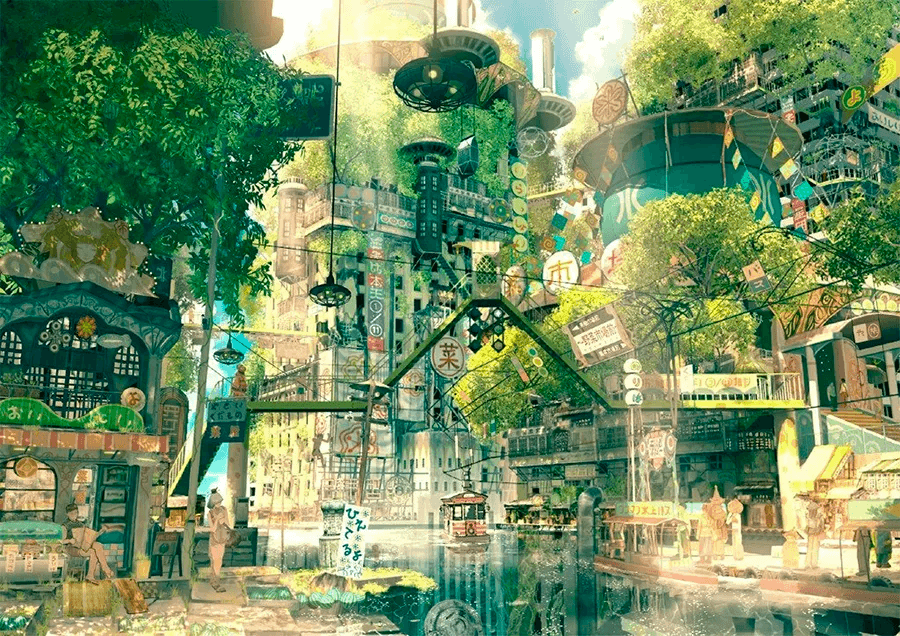
In doing so, it participates in a remarkable reversal. Rather than depict an oppositional logic that frames technology as a tool that can control nature (or lead to its destruction), this mode shows nature as a symbiotic and necessary partner in technological progress, a well of knowledge that we are only beginning to scratch. This nature-as-technics can be found in a range of practices that inspire this aesthetic: the cultivation of living bridges — or jing kieng jri, as it’s called in Khasi — which collapses botany with architecture and sculpture, challenging the boundaries between “natural” and “manmade”; Aztec floating gardens (or chinampa) which show how ancient techniques can help us adapt to modern crisis; or Masanobu Fukuoka’s “do nothing farming,” which avoids tillage, weeding, pesticides, or agro-chemical intervention yet results in yields comparable to conventional Japanese farmers, showcasing the intrinsic intelligences built into these organic systems.
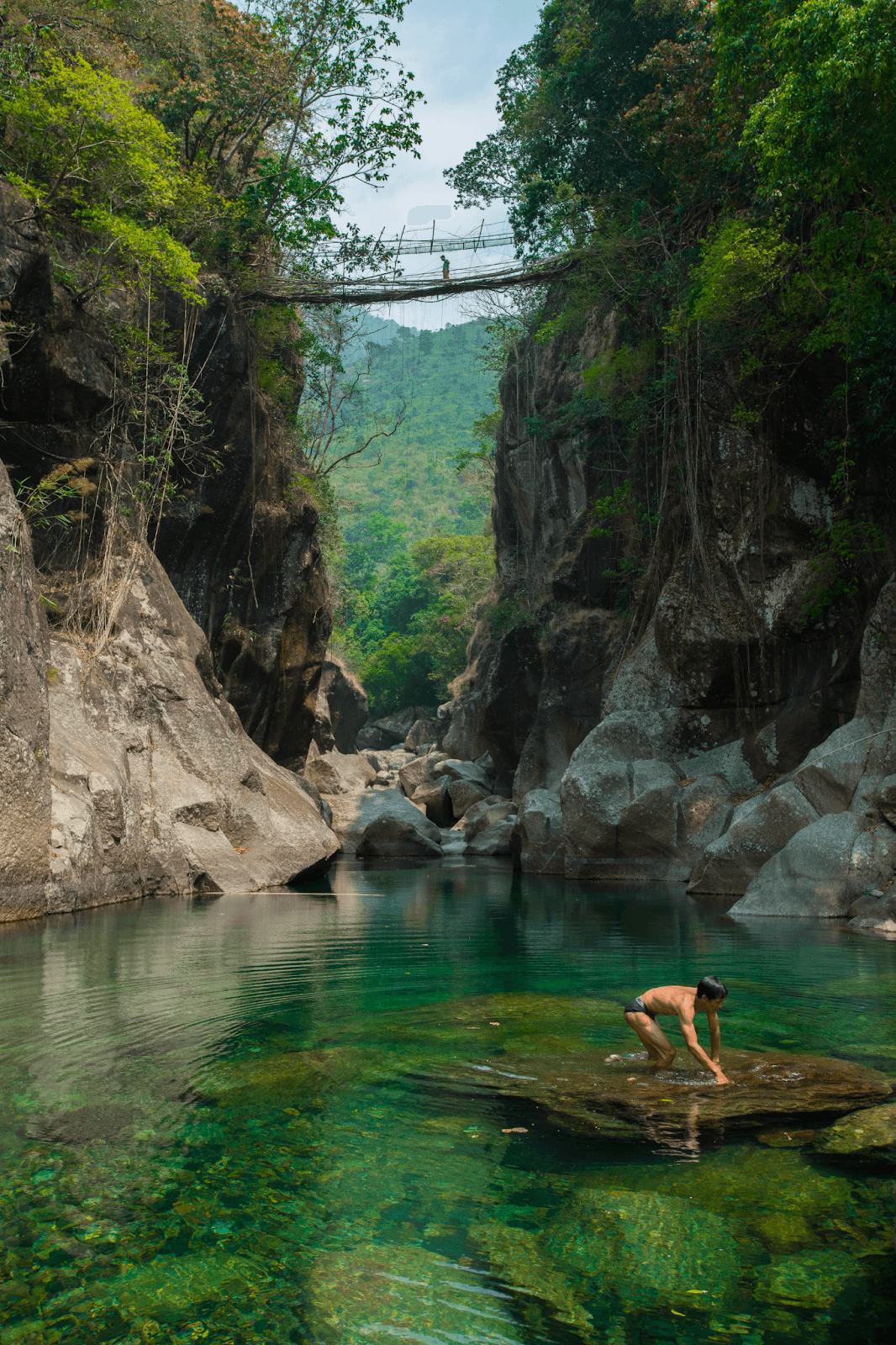
As one might guess from the sources of inspiration just noted, this mode doesn’t simply focus on crafting an aesthetic of the future — it’s also preoccupied with showcasing the techniques that might get us there. One futurist, Jay Springett, noted that “you can't LARP Solarpunk because LARPing Solarpunk is going out and planting a garden.” It is at heart an attempt to bridge aesthetics with praxis — to transform this visual form into an art like dance or music, where its beauty is inseparable from its doing. Creating images that inspire imaginative action, rather than passive consumption, cuts to the center of this project and remains a distinguishing feature of its political aims, evinced by events like the Solarpunk Action Week and ecofeminist art practices that blur the line between art and urban planning by crafting blueprints for imagined green infrastructures.
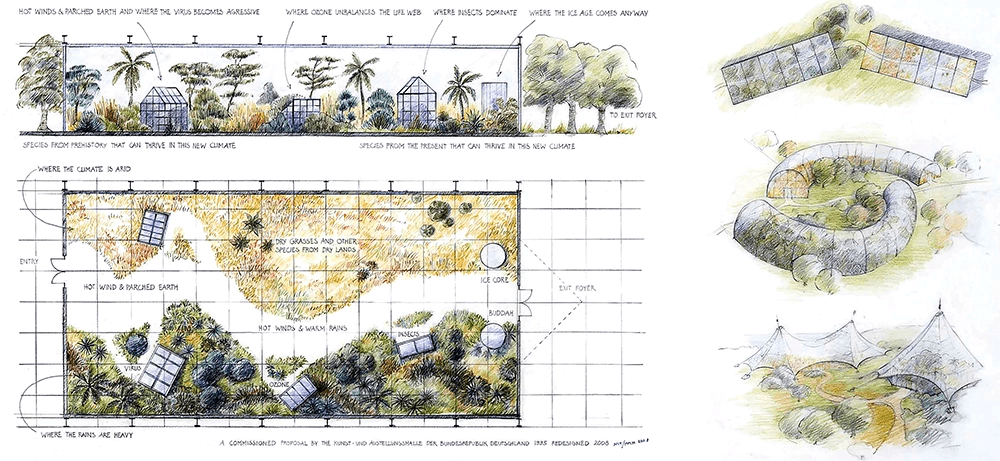
The more cynical set might critique this emergent media tradition as betraying a sort of naive optimism. But the post-apocalyptic dimension of this aesthetic, which is explicitly called out in one popular solarpunk manifesto, should make us wary of writing them off as blind idealists too quickly. Disaster remains a central component of this visual mode, and there’s no rose-tinted denial of its possibility. Moreover, this general constellation of media foregrounds voices and practices from those that have already faced calamity — Indigenous communities that have survived genocide, people in the Global South that have borne the brunt of our industrial greed — incorporating their modes of resistence into a broader approach. Rather than lean into despair and disengagement when confronted with apocalypse, this aesthetic gives form to what it might mean to move forward from it, to figure out how we might build something beautiful in its aftermath.
Rather than lean into despair and disengagement when confronted with apocalypse, this aesthetic gives form to what it might mean to move forward from it.
These new movements are techno-optimist, but strangely so — the “techno” subsumed by the natural green world, and the “optimist” as much about averting disaster as it is about being hopeful that if and when it happens, something worthwhile might arise from that too. This genre, as well as the media proximate to it — encompassing afrofuturism, Miyazaki’s ecologically minded post-apocalypses, ecofeminist art, and Indigenous speculative fiction — show us that media can do more than depress us or elicit urgency; they can give us north stars to work towards, even while acknowledging disaster. It also shows us what a techno-optimism for eco-crisis might look like: broader in its appreciation of what constitutes technology, and more malleable in how optimism might evolve to reckon with catastrophe.
Looking Forward
There are concerns that remain with all of the media strategies noted thus far. Climate deniers might find new ways to subvert scientific visualizations for their own ends, iconic photography and film may cease to be effective as their cultural connotations change, and new futurist aesthetics might be appropriated by companies aiming to greenwash their brands. But cultivating a diverse ecology of visual strategies means that there will be ways we can adapt to the challenges to come.
Media about climate change are critical in helping us confront the defining disaster of our age. In helping us see the invisible, these images are able to make climate change real to us, to help us cultivate a relationship to it. They operate simultaneously at the level of epistemology, ontology, affect, and praxis. Moreover, they give us the ability to make the future — another notoriously invisible subject — tangible to us as well, inspiring a path forward that goes beyond the oppositional modes we so often fall back on. Of course, these media will have to be paired with collective and radical action in order to have any sort of impact, but in their ability to galvanize sentiment and alter the way we see and engage with the world, they remain essential to any ecologically minded movement.
Leo Kim (he/him) is a writer based out of New York who spends his time overthinking contemporary media culture. His writing has appeared in Wired, Polygon, Real Life, and MOVIE.
Author
Leo Kim
Leo Kim is a writer based out of New York who spends his time overthinking contemporary media culture. His writing has appeared in _Wired_, _Polygon_, _Real Life_, and _MOVIE_.